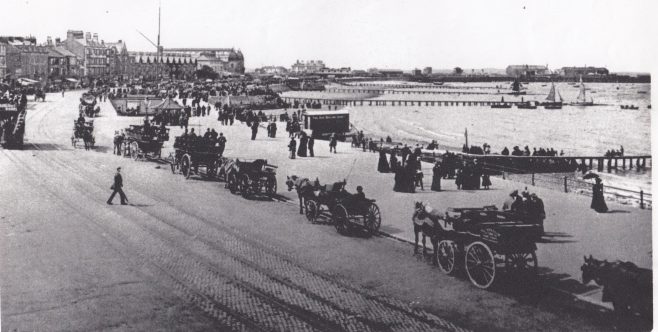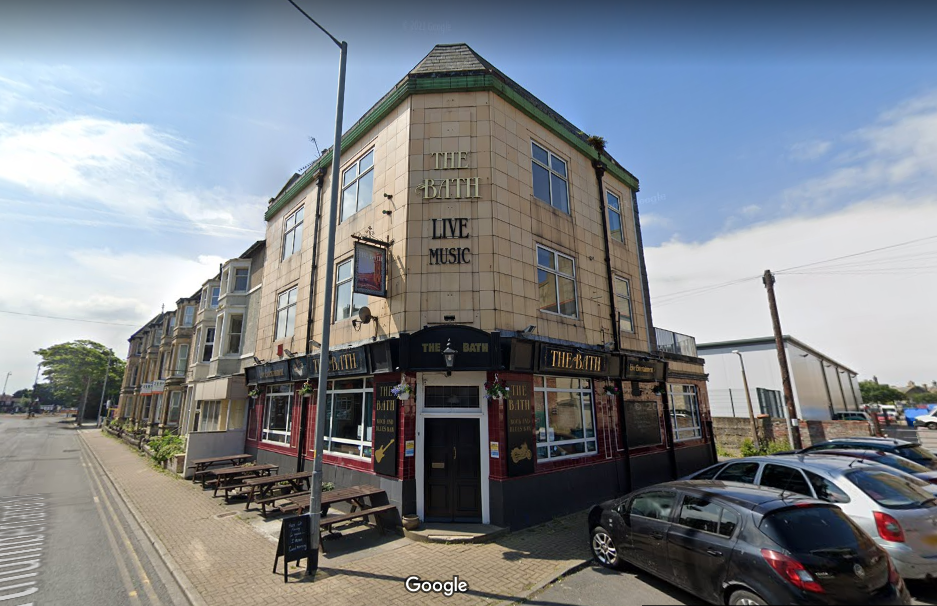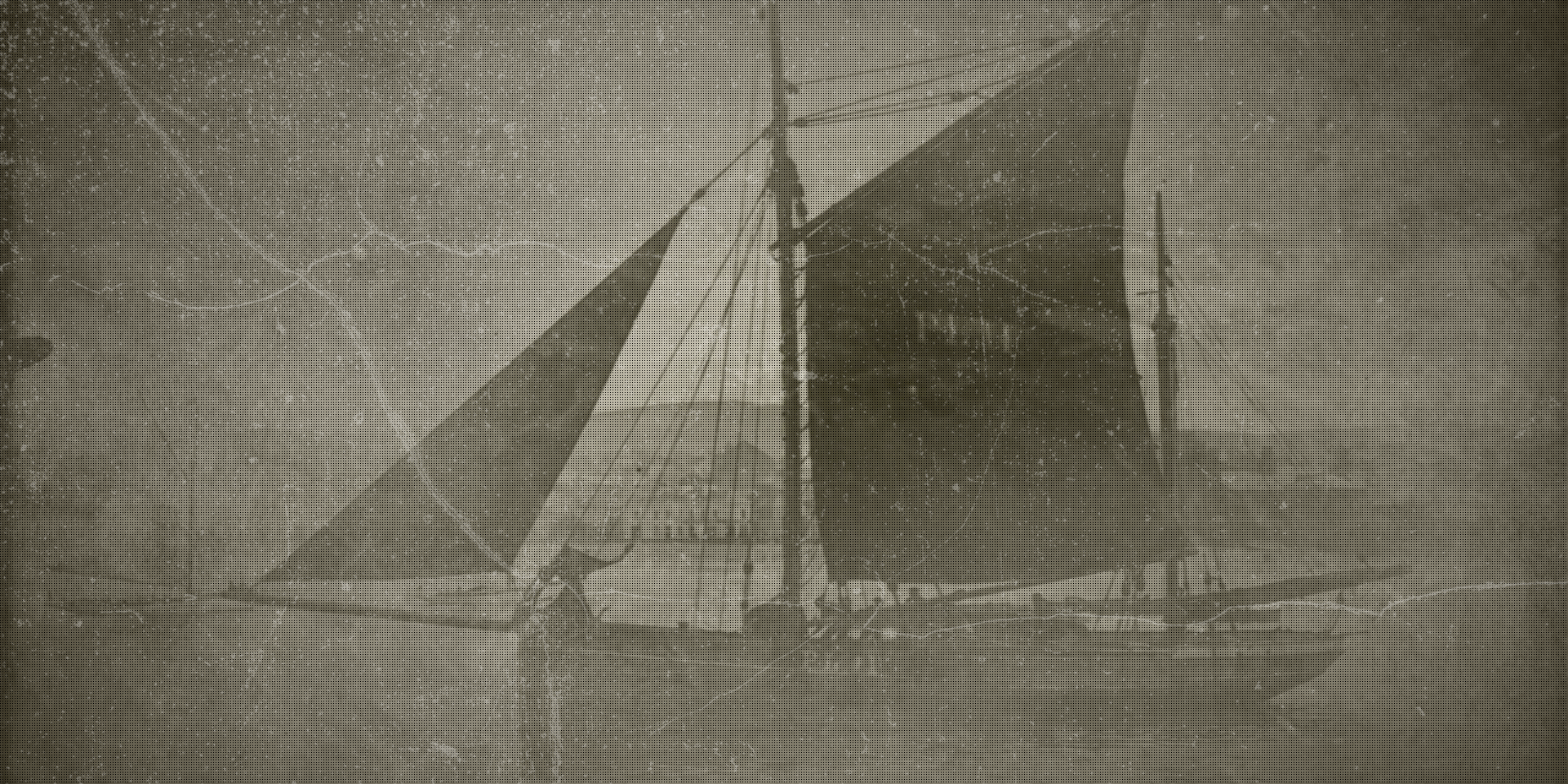![]()
On the morning of Monday, 3rd September, 1894 – 34 passengers made their way onto a sail-powered boat that would, on a normal day, have taken them on a leisurely trip over to Grange-over-Sands, located on the north side of Morecambe Bay, Cumbria. But what should have been a day of fun and enjoyment, it would quickly escalate into a day of tragedy.
Departing from Morecambe promenade and the Princess Sailing Company Landing Stage at around 10 o’clock in the morning, the passenger list comprised of a large contingent of holiday makers who had travelled over from Burnley.
The ‘Matchless‘ was a small fishing vessel, commonly known as a ‘Lancashire nobby’ and was used for fishing during the winter months and for pleasure trips in summer. Seventeen years old, the Matchless was roughly 33 feet (10m) long and weighed around five tons. It also contained a mainsail, foresail, topsail and jib.
Operated by its owner, 54 year old Samuel Houghton, who was an experience skipper with many years of sailing, after departing from the landing stage, the vessel wouldn’t take long to reach a stretch of water just off Silverdale and approximately six miles from where they had departed. The passengers, who, by now were in a merry mood and singing “Dare to be a Daniel!”, were oblivious to the impending danger that was fast approaching.
Moments later, the Matchless seemed to slow down and to the right, the water had darkened slightly. One of the passengers said to Houghton, “I think we have stopped altogether,” and then there was a lull, with the waters becoming still but very dark looking.
Out of nowhere, a huge gust slammed into the right side of the vessel, filling the sails and pitching it from left-to-right. And in no time at all, another gust struck from above, followed by a sudden squall, this time throwing the passengers into the water, leaving them no time to grab onto anything.
The Matchless began to rock from side-to-side before finally succumbing to the wind as she keeled over, and as the frantic passengers tried desperately to keep themselves afloat, it would only take a few minutes for the Matchless to disappear beneath the water.
Just over one-hundred yards away was Edward Gardner, a fisherman of Morecambe, who was also sailing his boat with seventeen passengers, taking the same route as that of Samuel on the Matchless.
Having just crossed over a junction in the channel and making headway towards Grange-over-Sands, Edward himself felt the gust of wind as it hit his boat. Looking over towards the direction of where the wind had originated from, he admitted to thinking to himself at a later inquest that the next breeze would be an ordinary breeze and did not think about altering the course of his boat.
He would later go on to mention that the wind was more akin to that of being like a whirlwind, first crashing along one side before rounding his boat and hitting it head-on the opposite side.
However, whilst he had managed to control his boat, he would see the Matchless pitching over and disappearing into the sea. Instinctively, he turned his boat around to make haste towards the panic-stricken passengers in the water.
In total he helped to recover six passengers who were alive and one, unfortunately who had died.
All around him were bits and pieces from the Matchless floating on the water with passengers clinging onto them.
Another witness, that of Joseph Wilson, also a fisherman, was also close by, around half-a-mile away from the Matchless. And just like that of Edward Gardner, after witnessing the carnage unfolding behind him, he turned his boat around to offer help. Other boats also in the area had by now also turned around to offer assistance.
Passengers from the other boats which had arrived to offer help, held out their hands from all sides, trying desperately to grab hold of the unfortunate people who were struggling violently for assistance.
In total, just seven people would be rescued – three men, two women and two children. Two bodies pulled from the water would include one man and one woman. As for the rescued, one of them would be that of Samuel Houghton, owner of the Matchless.
After circling the area until it became apparent that no further aid could be given, two boats returned to Morecambe at around half-past one, bringing with them the full horror of the tragedy.

The first notion that something was wrong appeared when the seemingly lifeless body of a young woman was brought ashore opposite the People’s Palace and transported to the nearby Bath Hotel. She was followed almost immediately by a boy and a girl, both who were partially conscious.
Panic prevailed, with messengers being sent to fetch for the help of doctors and medical staff.
As for the young woman, the efforts of Police-constable Johnson, a cab inspector by the name of Lamb and a fishman named Adam Woodhouse, who persevered for around three-hours in trying to keep her alive, would successfully bring her around, and if it wasn’t for their help she would most certainly have died that afternoon.
Meanwhile, search boats had left the bay to try and recover the bodies of those still missing and it wouldn’t take long before the first of them returned, bringing back with them several bodies which were later transferred over into the changing rooms of a football club, situated just behind the King’s Arms Hotel, which had been turned into a temporary mortuary.
The search would go on into the night and local police were sent out in small parties at different points to examine the sands once the tide had receded.
Up to midnight, only four bodies had been found, with just one being identified.
Relatives and friends, all concerned on the whereabouts of those who were still missing remained close by to the mortuary throughout the night, all anxious to know the fate of those close to them.
A yachtsman, who had been out searching, would pick up nine bodies, had to wait a further nine hours before he could return, due to the state of the tide being too far out and therefore making it impossible to reach the landing stage at Morecambe Bay.
Upon his arrival, all nine bodies were transferred to the make-shift mortuary and identified by those still waiting to hear news of their loved ones.
At half-past nine the following morning, the Coroner’s Court opened and in total, sixteen bodies, with one exception, had been identified.
And up until the late hours of Tuesday, 4th September, no more bodies would be recovered, apart from that of an unknown man who, it would later emerge was that of 27 year old, Fred Newton.
A committee meeting of the Local Board was quickly set up on Tuesday, 4th September, during which it was decided to start a fund in aid of those who had lost someone close to them. The nine members of the board, together with the Clerk and surveyor, each donated one guinea, and it was agreed that sheets would be placed on the promenade to collect donations towards the fund.
The inquest into the tragedy, took place at the King’s Arms Hotel and before Mr. Lawrence Holden, Coroner for the South Lonsdale, he was joined by a representative jury, of which Mr. John Lee (Chairman of the Local Board) was foreman. Superintendent Bryning, Inspector Hodgson and Police Sergreant Petch were also present.
Joseph Hamer was one of the first witnesses to be called. A carter from Ramsbottom, he would identify the body of 54 year old, Samuel Brooks, as that of his uncle. He would also identify the body of his aunt, Mrs. Ann Williams, 51 years of age and the widow of a tailor.
Stewart Watmough, from Bradford gave identification on the body of his cousin, 24 years of age, Joseph Fawcett Carter, a reporter working for the Bradford Observer.

Other witness came forwards, simply to identify the bodies, with John Heaton identifying the body of 55 year old, Wright Shepherd. But more upsetting was that of his father, also named John Heaton, who was 51 years old.
The last to give evidence was John Clegg, a weaver from Burnley who identified the body of Edmund Clegg, a cotton overlooker aged 50, as that of his father. Clegg would also identify the body of John Parkinson, overlooked, 36 years and also from Burnley.
With no other witnesses available to identify other bodies, the inquest was adjourned to half-past nine the following morning.
The next day’s inquest would turn out to be one of great concern and anxiety, especially for the families and friends of the passengers involved in the tragedy as it would be an extremely quick one at that.
Several witnesses were called, including that of James Boothman, just one of the survivors of the Matchless. He would go into detail as to the events that transpired on the Monday. He would also go on to tell the jury that no life belts were in the boat and he had somehow managed to stay conscious throughout the ordeal.
Another survivor, that of Benjamin Robinson, who was sat next to Boothman spoke of standing up on the Matchless, to stretch his legs, when suddenly a gust of wind took Boothman’s billycock (cap) and then the boat was ‘over’ in an instant.
Police-inspector Hodgson deposited that 16 bodies had been recovered. Nine persons were rescued and there were still nine missing – namely, Alice Greenwood, aged 38; Arthur Clegg, aged 4; Mary Alice Webster, aged 26; Edith Webster, aged 5; Florence Carter, aged 23; Sarah Whitehead, aged 42; Fred Whitehead, 14 months; Elijah Monks, aged 60; and Eliza Ann Heaton, aged 14.
In what seems to have been a rushed inquest, after further witnesses had been recalled, including Edward Gardner, Richard Gardner, Joseph Wilson and that of Samuel Houghton, and after an hour’s adjournment for luncheon, the jury – after just ten minutes of deliberation, returned a verdict of “Accidentally drowned.”
The foreman of the jury wished to exonerate Samuel Houghton from any carelessness or blame. They jury also promised to recommend certain things to the Board of Trade, such as to limiting the number of passengers to be carried in each boat and making the provisions of life-saving appliances in such boats compulsory. They jury wanted to also to draw the attention to the heroic conduct of all the boatmen, especially those of Edward and Richard Gardner, and they asked the coroner to recommend them to the Royal Humane Society for a medal.
After the close of the inquest, most of the bodies were removed from the temporary mortuary at the football club and taken to their respective homes. A hearse had already been engaged for some time conveying the bodies, encased in neat looking pine coffins with brass and other fittings, to the railway station. Many were accompanied by relatives and members of the Relief Committee, by whom the arrangements were superintended.

A hastily-arranged memorial service was held in St. Lawrence Church and led, in part, by the Reverend W. H. Disney, Rector of Winwick, Rugby, who was taking duty for the Record of Morecambe at that time. Other religious men to take part were the Reverend D. Schofield, Vicar of Wyresdale; Reverend J. A. Jackson, Curate of the Parish Church and the Reverend A. T. Warne, Curate-in-charge of West End Mission Church.
On the 12th September, the Morecambe Local Board committee held a meeting, primarily to discuss the recent tragedy and how instances of this could be prevented in the future, and during this meeting it was agreed upon by the committee members to close the fund, with the amount collected reaching £236 11s 9d,- around £19,407.74 in today’s value.
The committee also agreed that whilst the fund may now be officially closed, they would still accept any future payments.
And on Saturday, 29th September, the Lancaster Guardian published a short article regarding the `Burnley Disaster relief fund’, saying it had reached nearly £600 (£49,229.58p), which was regarded as being a very creditable effort. This figure would eventually raise even higher and reach over £700 by the end of October.
Whilst the Morecambe fund was used to fund coffins and the transportation of the bodies to their homes, the Burnley fund was used for the most needy of the families and relatives of the Burnley victims.
The article would also mention the names of two victims that were still undiscovered – Alice Greenwood and Arthur Clegg.
Arthur Clegg, who was aged just four, would be discovered on Monday, 1st October, as would the body of Alice Greenwood, both picked up by local fishermen.
Other bodies would eventually be recovered from a varying number of areas around the bay, with some being as far away as Ulverston. And in total, only 16 out of the 25 victims’ bodies would be discovered within the first 24 hours of the tragedy.


As with the other victims whose bodies had been found days after the tragedy, an inquest would be held at the King’s Arms Hotel, with the jury being practically the same as that which had served during three previous occasions.
Unfortunately, not all of the 34 passengers who had been present on the Matchless during that fateful day would be found within days of the tragedy, and it would take several months before the final victim would be named, that of Mrs. Florence Carter, whose body would be found washed up on the Grange on Monday, 14th January, 1895 – five months after disappearing beneath the waves. She was just 23 years of age.
It seems that the haste and speediness of the inquest also angered the families and friends of the victims, as it never gave them time to make arrangements to travel and to hear the outcome. It has since been written that the inquest was simply a total ‘whitewash’ as the foreman of the jury was the chairman of the local authority, and because of this, there was a certain interest in maintaining the town’s reputation as a safe resort for travelling tourists.
The survivors;
- Ben Brierley, 7, Burnley
- Ben Robinson, 47, Burnley
- Betty Brooks, 58, Ramsbottom
- Elizabeth Walker, 25, Burnley
- Esther Clegg, 47, Burnley
- Fanny Brierley, 9, Burnley
- James Boothman, 23, Burnley
- Samuel Houghton, 54, Morecambe
- William Milner, 53, Skipton
The deceased;
- Alice Greenwood, 38, Burnley
- Ann Ingham, 43, Burnley
- Ann Williams, 41, Ramsbottom
- Arthur Clegg, 4, Burnley
- Dick Whitehead, 17, Burnley
- Doris Carter, 2, Bradford
- Edith Webster, 5, Skipton
- Edmund Clegg, 49, Burnley
- Elijah Monks, 60, Bolton
- Eliza Ann Heaton, 14, Manchester
- Florence Carter, 23, Bradford
- Florrie Robinson, 15, Burnley
- Fred Newton, 27, Liversedge
- Fred Whitehead, 1, Burnley
- John Heaton, 51, Manchester
- John Parkinson, 36, Burnley
- Jonas Webster, 50, Skipton
- Joseph F Carter, 26, Bradford
- Mary A Webster, 26, Skipton
- Samuel Brooks, 54, Ramsbottom
- Sarah Hargreaves, 59, Burnley
- Sarah Robinson, 45, Burnley
- Sarah Whitehead, 43, Burnley
- William Brierley, 41, Burnley
- Wright Shepherd, 55, Bolton
Sources used in this story;
Western Daily Press – Tuesday 04 September 1894
Bristol Mercury – Tuesday 04 September 1894
Derby Mercury – Wednesday 05 September 1894
Blackburn Standard – Saturday 08 September 1894
Burnley Express – Wednesday 12 September 1894
+ many more courtesy of the British Newspaper Archive – www.britishnewspaperarchive.co.uk and www.ancestry.co.uk
Please follow me on social media;
Twitter – https://twitter.com/dohpods
Instagram – www.instagram.com/dohpods
Youtube – https://www.youtube.com/c/DaysofHorrorPodcast
The Helmshore Memorial Fund – https://gofund.me/b872db37
Music;
Casual Desire – Ugonna Onyekwe – No Copyright Music
Contact – The Tower of Light – No Copyright Music
Another Day – Myuu – No Copyright Music
Dare to be a Daniel – SE Samonte – https://www.youtube.com/watch?v=My9rYr8xzng&t=29s


Leave a Reply